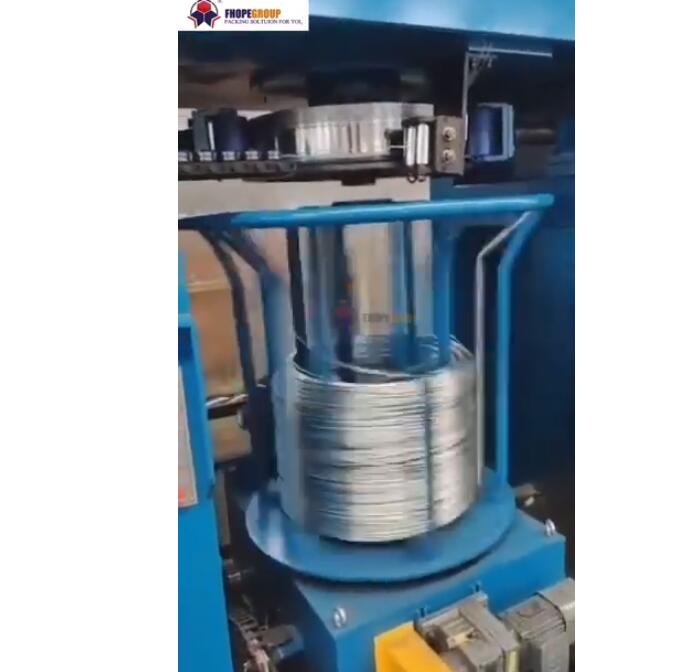Optimizing Wire Processing: Inside High-Speed Automatic Winding Machines with Integrated Accumulation
The relentless demand for increased productivity and quality in wire and cable manufacturing necessitates advanced automation solutions. This video showcases a high-speed online automatic wire winding machine, integrating key technologies like accumulation and automated handling to streamline operations. Such systems represent a significant leap forward from traditional batch processes, addressing bottlenecks and enhancing overall equipment effectiveness (OEE).
Core Technology: High-Speed Precision Winding
At the heart of the system lies the high-speed winding unit. Achieving rapid, yet precise, coiling requires sophisticated engineering:
- Drive Systems: Typically employ high-torque servo motors coupled with advanced motion controllers. These allow for rapid acceleration/deceleration and precise speed regulation, crucial for maintaining consistent wire tension and achieving specified coil dimensions. Speeds can often exceed several hundred meters per minute, depending on wire gauge and coil specifications.
- Traverse Mechanism: A precision traverse system, often utilizing ball screws or servo-driven belt systems, guides the wire accurately across the spool or core. This ensures level winding patterns (e.g., orthocyclic winding for maximum density, as described in various winding technology patents like US Patent XXXXXXX - Note: Replace XXXXXXX with a relevant example if found, or keep general), preventing wire overlaps and ensuring coil stability.
- Tension Control: Maintaining consistent tension is paramount to prevent wire stretching, deformation, or slack, which impacts coil quality and downstream processes. Modern systems utilize dynamic tension control, often incorporating:
- Dancer Arms: Provide mechanical buffering and feedback to the drive system.
- Load Cells: Offer direct tension measurement for closed-loop control.
- Motor Torque Control: Servo drives can precisely regulate torque to infer and control tension.
Research published in journals like the IEEE Transactions on Industrial Electronics often details advanced algorithms for optimizing tension control during high-speed transients.
The Crucial Role of the Integrated Accumulator
The "online" capability highlighted signifies continuous operation, often receiving wire directly from an upstream process like extrusion or drawing. The integrated accumulator is essential for decoupling the continuous upstream process from the intermittent winding cycle (spool changeover).
- Buffering Capacity: The accumulator stores a defined length of wire, allowing the upstream process to continue running while the winder performs a full-spool cut, transfer, and new-spool start sequence. This eliminates costly line stoppages.
- Design Variants: Accumulators can be vertical or horizontal loop designs, often using low-friction rollers and dancer control to manage wire tension dynamically within the buffer zone, preventing damage to the wire insulation or conductor. Their design principles are frequently outlined in process automation patents focusing on continuous material handling.
Automation Extending Beyond Winding: The Turntable Trolley
The video demonstrates an automatic turntable trolley system. This feature significantly enhances automation and logistical efficiency:
- Automated Coil Handling: Once a coil reaches the desired length, the system typically performs an automatic cut-and-transfer operation. The completed coil is then automatically ejected or moved onto the turntable trolley.
- Ergonomics and Safety: This eliminates heavy manual lifting and handling of wire coils, reducing ergonomic risks and improving operator safety, a key focus in modern factory automation highlighted in publications like Automation World.
- Streamlined Logistics: The trolley can queue multiple finished coils, facilitating efficient transfer to downstream processes such as automatic strapping, wrapping, palletizing, or directly to inventory/shipping areas. This minimizes work-in-progress (WIP) and optimizes material flow.
System Integration and Control
The entire apparatus operates under a centralized Programmable Logic Controller (PLC).
- Synchronization: The PLC orchestrates the complex synchronization between the incoming wire feed, accumulator buffering, winder speed, traverse movement, cutting mechanism, and the turntable handling system.
- Human-Machine Interface (HMI): A touchscreen HMI typically provides operators with process visualization, parameter setting (coil dimensions, speed, tension), diagnostics, and recipe management.
- Connectivity: Advanced systems may offer Ethernet/IP or Profinet connectivity for integration into plant-wide Manufacturing Execution Systems (MES) or SCADA systems, aligning with Industry 4.0 principles.
Technical Considerations and Performance Metrics
While specific parameters vary by model and application, typical specifications often include:
- Winding Speed: 100 - 800 m/min (or higher, depending on wire type)
- Applicable Wire Diameters: Wide range, e.g., 0.5 mm - 6 mm
- Coil Dimensions: Configurable (Max OD, Max Width, Core Diameter)
- Tension Range & Accuracy: e.g., 10 - 200 N, ± 5%
- Accumulator Capacity: e.g., 50 - 500 m
- Control System: Major PLC brands (Siemens, Allen-Bradley, Beckhoff)
Conclusion: Driving Efficiency in Wire Handling
High-speed online automatic wire winding machines, complete with integrated accumulators and handling systems like turntable trolleys, represent a critical technology for manufacturers seeking competitive advantages. As documented in technical resources and industry case studies found in publications like Wire & Cable Technology International or Machine Design, these systems deliver significant benefits in throughput, product consistency, operational efficiency, and operator safety. They are indispensable tools in optimizing the modern wire and cable production workflow.
This video showcases an automated wire winding solution embodying these advanced principles.
For more specific technical details or inquiries regarding implementation, please contact via email info@fhopepack.com.


